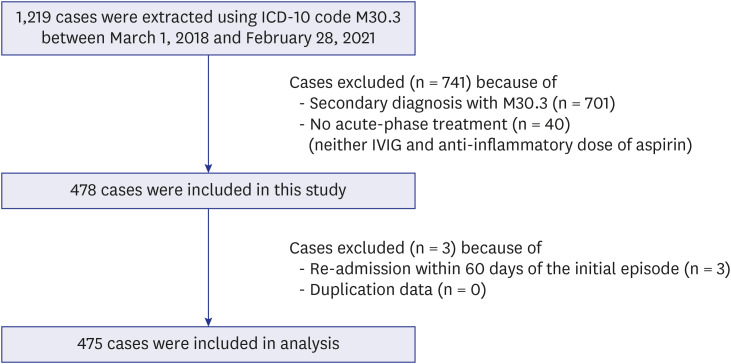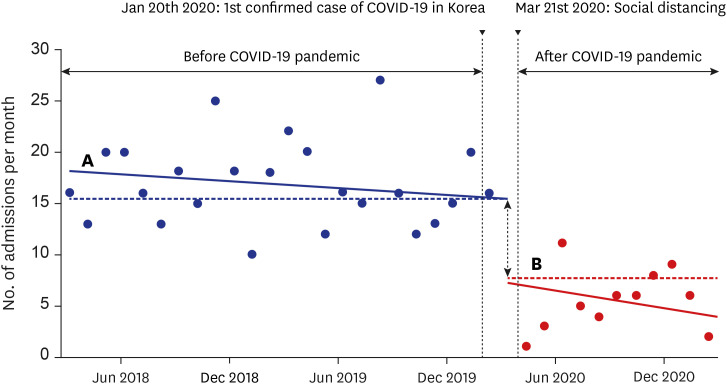J Korean Med Sci.
2022 May;37(20):e141. 10.3346/jkms.2022.37.e141.
Changes in the Clinical Characteristics of Kawasaki Disease After Coronavirus Disease (COVID-19) Pandemic: A Database Analysis
- Affiliations
-
- 1Department of Pediatrics, College of Medicine, The Catholic University of Korea, Seoul, Korea
- 2Department of Preventive Medicine and Public Health, College of Medicine, The Catholic University of Korea, Seoul, Korea
- 3Department of Pediatrics, Seoul National University Bundang Hospital, Seongnam, Korea
- 4Department of Pediatrics, Seoul National University College of Medicine, Seoul, Korea
- KMID: 2530103
- DOI: http://doi.org/10.3346/jkms.2022.37.e141
Abstract
- Background
The impact of the coronavirus disease 2019 (COVID-19) pandemic on Kawasaki disease (KD) has not yet been established. We investigated changes in the observed number and severity of KD cases and accompanying coronary artery complications during the COVID-19 pandemic in Korea.
Methods
This retrospective observational study included patients aged < 18 years with acute-phase KD diagnosed between March 2018 and February 2021. Data were extracted from the Clinical Data Warehouse that houses data from five affiliated university hospitals in Korea. We analyzed changes in the number of patient admissions and clinical characteristics, including cardiac complications, before and after the onset of the COVID-19 pandemic.
Results
A total of 475 admissions were included in the analysis. After March 2020, we observed a significant decrease of 33% in the number of hospitalizations for KD compared with the average number of hospitalizations during the previous 2 years. The number of admissions per month significantly decreased by 7.9 persons/month (95% confidence interval, −13.8 to −2.0; P < 0.05) compared with that before COVID-19. By contrast, the proportion of patients aged < 1 year with KD increased. The proportion of patients with refractory KD and the rate of cardiac complications did not change significantly.
Conclusion
Since the onset of the COVID-19 pandemic, the total number of hospital admissions for KD has decreased in Korea. Although the proportion of admissions of infants aged < 1 year increased, no changes were observed in clinical courses and complications.
Figure
Reference
-
1. McCrindle BW, Rowley AH, Newburger JW, Burns JC, Bolger AF, Gewitz M, et al. Diagnosis, treatment, and long-term management of Kawasaki disease: a scientific statement for health professionals from the American Heart Association. Circulation. 2017; 135(17):e927–e999. PMID: 28356445.2. Singh S, Vignesh P, Burgner D. The epidemiology of Kawasaki disease: a global update. Arch Dis Child. 2015; 100(11):1084–1088. PMID: 26111818.3. Kim GB, Eun LY, Han JW, Kim SH, Yoon KL, Han MY, et al. Epidemiology of Kawasaki disease in South Korea: a nationwide survey 2015-2017. Pediatr Infect Dis J. 2020; 39(11):1012–1016. PMID: 33075217.4. Rife E, Gedalia A. Kawasaki disease: an update. Curr Rheumatol Rep. 2020; 22(10):75. PMID: 32924089.5. Cucinotta D, Vanelli M. WHO declares COVID-19 a pandemic. Acta Biomed. 2020; 91(1):157–160. PMID: 32191675.6. Ministry of Health and Welfare. Coronavirus disease-19, Republic of Korea. Updated 2021. Accessed August 1, 2021. http://ncov.mohw.go.kr/en .7. Park IN, Yum HK. Stepwise strategy of social distancing in Korea. J Korean Med Sci. 2020; 35(28):e264. PMID: 32686376.8. Ministry of Health and Welfare. All about Korea’s response to COVID-19. Updated October 13, 2020. Accessed August 16, 2021. https://www.mofa.go.kr/eng/brd/m_22742/view.do?seq=35&srchFr=&srchTo=&srchWord=&srchTp=&multi_itm_seq=0&itm_seq_1=0&itm_seq_2=0&company_cd=&company_nm=&page=1&titleNm= .9. Kuitunen I, Artama M, Mäkelä L, Backman K, Heiskanen-Kosma T, Renko M. Effect of social distancing due to the COVID-19 pandemic on the incidence of viral respiratory tract infections in children in Finland during early 2020. Pediatr Infect Dis J. 2020; 39(12):e423–e427. PMID: 32773660.10. Goldman RD, Grafstein E, Barclay N, Irvine MA, Portales-Casamar E. Paediatric patients seen in 18 emergency departments during the COVID-19 pandemic. Emerg Med J. 2020; 37(12):773–777. PMID: 33127743.11. Lin CF, Huang YH, Cheng CY, Wu KH, Tang KS, Chiu IM. Public health interventions for the COVID-19 pandemic reduce respiratory tract infection-related visits at pediatric emergency departments in Taiwan. Front Public Health. 2020; 8:604089. PMID: 33392141.12. Choi DH, Jung JY, Suh D, Choi JY, Lee SU, Choi YJ, et al. Impact of the COVID-19 outbreak on trends in emergency department utilization in children: a multicenter retrospective observational study in Seoul metropolitan area, Korea. J Korean Med Sci. 2021; 36(5):e44. PMID: 33527786.13. World Health Organization. International Statistical Classification of Diseases and Related Health Problems (ICD). Accessed June 2, 2021. https://www.who.int/standards/classifications/classification-of-diseases .14. Hirata S, Nakamura Y, Yanagawa H. Incidence rate of recurrent Kawasaki disease and related risk factors: from the results of nationwide surveys of Kawasaki disease in Japan. Acta Paediatr. 2001; 90(1):40–44. PMID: 11227331.15. Wagner AK, Soumerai SB, Zhang F, Ross-Degnan D. Segmented regression analysis of interrupted time series studies in medication use research. J Clin Pharm Ther. 2002; 27(4):299–309. PMID: 12174032.16. Sano T, Kurotobi S, Matsuzaki K, Yamamoto T, Maki I, Miki K, et al. Prediction of non-responsiveness to standard high-dose gamma-globulin therapy in patients with acute Kawasaki disease before starting initial treatment. Eur J Pediatr. 2007; 166(2):131–137. PMID: 16896641.17. Kleinman ME, Chameides L, Schexnayder SM, Samson RA, Hazinski MF, Atkins DL, et al. Part 14: pediatric advanced life support: 2010 American Heart Association guidelines for cardiopulmonary resuscitation and emergency cardiovascular care. Circulation. 2010; 122(18):Suppl 3. S876–S908. PMID: 20956230.18. Kang JM, Kim YE, Huh K, Hong J, Kim DW, Kim MY, et al. Reduction in Kawasaki Disease after nonpharmaceutical interventions in the COVID-19 era: a nationwide observational study in Korea. Circulation. 2021; 143(25):2508–2510. PMID: 34092115.19. Kim M, Chae KH, Chung YJ, Hwang H, Lee M, Kim HK, et al. The effect of the look-back period for estimating incidence using administrative data. BMC Health Serv Res. 2020; 20(1):166. PMID: 32131818.20. Ristevski B, Chen M. Big data analytics in medicine and healthcare. J Integr Bioinform. 2018; 15(3):20170030.21. Hara T, Furuno K, Yamamura K, Kishimoto J, Mizuno Y, Murata K, et al. Assessment of pediatric admissions for Kawasaki disease or infectious disease during the COVID-19 state of emergency in Japan. JAMA Netw Open. 2021; 4(4):e214475. PMID: 33822065.22. Iio K, Matsubara K, Miyakoshi C, Ota K, Yamaoka R, Eguchi J, et al. Incidence of Kawasaki disease before and during the COVID-19 pandemic: a retrospective cohort study in Japan. BMJ Paediatr Open. 2021; 5(1):e001034.23. Ae R, Shibata Y, Kosami K, Nakamura Y, Hamada H. Kawasaki disease and pediatric infectious diseases during the coronavirus disease 2019 pandemic. J Pediatr. 2021; 239:50–58.e2. PMID: 34324881.24. Kim JH, Roh YH, Ahn JG, Kim MY, Huh K, Jung J, et al. Respiratory syncytial virus and influenza epidemics disappearance in Korea during the 2020-2021 season of COVID-19. Int J Infect Dis. 2021; 110:29–35. PMID: 34245886.25. Choi A, Bae W, Kim K, Kim S. Impact of Covid-19 on the visit of pediatric patients with injuries to the emergency department in Korea. Children (Basel). 2021; 8(7):568. PMID: 34356547.26. Davis AL, Sunderji A, Marneni SR, Seiler M, Hall JE, Cotanda CP, et al. Caregiver-reported delay in presentation to pediatric emergency departments for fear of contracting COVID-19: a multi-national cross-sectional study. CJEM. 2021; 23(6):778–786. PMID: 34402036.27. Ciacchini B, Tonioli F, Marciano C, Faticato MG, Borali E, Pini Prato A, et al. Reluctance to seek pediatric care during the COVID-19 pandemic and the risks of delayed diagnosis. Ital J Pediatr. 2020; 46(1):87. PMID: 32600464.28. Lazzerini M, Barbi E, Apicella A, Marchetti F, Cardinale F, Trobia G. Delayed access or provision of care in Italy resulting from fear of COVID-19. Lancet Child Adolesc Health. 2020; 4(5):e10–e11. PMID: 32278365.29. Shulman S, Geevarghese B, Kim KY, Rowley A. The impact of social distancing for COVID-19 upon diagnosis of Kawasaki disease. J Pediatric Infect Dis Soc. 2021; 10(6):742–744. PMID: 33755140.30. Do YS, Kim KW, Chun JK, Cha BH, Namgoong MK, Lee HY. Predicting factors for refractory Kawasaki disease. Korean Circ J. 2010; 40(5):239–242. PMID: 20514335.31. Okada S, Hasegawa S, Suzuki Y, Matsubara T, Shimomura M, Okuda M, et al. Acute pericardial effusion representing the TNF-α-mediated severe inflammation but not the coronary artery outcome of Kawasaki disease. Scand J Rheumatol. 2015; 44(3):247–252. PMID: 25351965.32. Verdoni L, Mazza A, Gervasoni A, Martelli L, Ruggeri M, Ciuffreda M, et al. An outbreak of severe Kawasaki-like disease at the Italian epicentre of the SARS-CoV-2 epidemic: an observational cohort study. Lancet. 2020; 395(10239):1771–1778. PMID: 32410760.33. Feldstein LR, Rose EB, Horwitz SM, Collins JP, Newhams MM, Son MBF, et al. Multisystem inflammatory syndrome in U.S. children and adolescents. N Engl J Med. 2020; 383(4):334–346. PMID: 32598831.34. Ebina-Shibuya R, Namkoong H, Shibuya Y, Horita N. Multisystem inflammatory syndrome in children (MIS-C) with COVID-19: insights from simultaneous familial Kawasaki Disease cases. Int J Infect Dis. 2020; 97:371–373. PMID: 32553716.35. Fukuda S, Kaneta M, Miyake M, Ohya T, Miyakawa K, Iwamoto M, et al. A case of multisystem inflammatory syndrome in children in a Japanese boy: with discussion of cytokine profile. Mod Rheumatol Case Rep. 2021; 5(2):442–447. PMID: 33904379.36. Choe YJ, Choi EH, Choi JW, Eun BW, Eun LY, Kim YJ, et al. Surveillance of COVID-19-associated multisystem inflammatory syndrome in children, South Korea. Emerg Infect Dis. 2021; 27(4):1196–1200. PMID: 33539720.37. Iio K, Uda K, Hataya H, Yasui F, Honda T, Sanada T, et al. Kawasaki disease or Kawasaki-like disease: influence of SARS-CoV-2 infections in Japan. Acta Paediatr. 2021; 110(2):600–601. PMID: 32799392.38. Kim YJ, Park H, Choi YY, Kim YK, Yoon Y, Kim KR, et al. Defining association between COVID-19 and the multisystem inflammatory syndrome in children through the pandemic. J Korean Med Sci. 2020; 35(22):e204. PMID: 32508068.
- Full Text Links
- Actions
-
Cited
- CITED
-
- Close
- Share
- Similar articles
-
- The coronavirus disease 2019 pandemic and chronic diseases
- Age-Related Morbidity and Mortality among Patients with COVID-19
- Clinical and Epidemiological Characteristics of Coronavirus Disease 2019 in the Early Stage of Outbreak
- COVID-19 from the Perspective of a Gastroenterologist
- Diagnosis and management of Kawasaki disease



